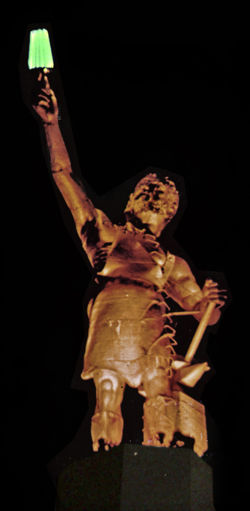Vulcan's torch
Vulcan's torch, sometimes called the Light for Life, was a neon-lit beacon constructed over the spearhead held high in the Vulcan statue's right hand to serve as the focus of a traffic safety campaign planned by the Birmingham Jaycees. The beacon was intended to have the form of a torch, but gave the effect of a "neon popsicle".
The concept of using a color-coded beacon was first proposed by R. Paul Moon, who chaired a safety committee for the Jaycees. The light would be glow green until a traffic fatality was reported, and then turn red for 24 hours as a warning to others. Moon's initial idea was to mount the beacon atop a tall flagpole outside the West End Library. Someone else suggested that the roof of the downtown Comer Building would be more visible. Then came the suggestion that employing Vulcan as the bearer of the beacon would combine high visibility with the sculpture's Olympian authority.
Jaycee's president Clarence Boggan brought the idea to the Birmingham Park & Recreation Board, which referred it to an ad hoc committee of Mrs Sharp and Mr Beck. The proposal was for the torch to be installed temporarily, and removed at the conclusion of the safety campaign. Fund-raising for the construction of the torch was led by Moon and his co-chair's George Seibels and Walter Nichols. J. L. Glasser obtained the final approvals needed from the Park Board while the Alabama Neon Sign Company designed and engineered the torch itself.
The torch was designed to wrap around the existing "arrow" or "thunderbolt" (itself a replacement for the original spearpoint, lost during the statue's move to Birmingham from St Louis in 1905.) The truncated cone-shaped metal shroud was mounted so that it could be rotated, allowing access to all of sixteen neon tubes from one accessible location. In order for workmen to reach the statue's arm, metal climbing rungs were welded to Vulcan's left hip and chest. A cable attached to his right hand provided the means to scale the arm. Some reported that the workers would climb through the inside of the statue and reach the torch from an access panel in the hand, but the size of the casting and the fact that the statue was filled chest-high with concrete makes that version very unlikely.
Ralph Fesperman was the sign company employee that performed the installation of the torch. He scaled the statue without any harnesses, provoking fears from the Jaycee's watching from below that their "Safety Campaign" could well be aborted by an ironic tragedy. Fesperman brushed aside Moon's repeated concerns for his security and completed the work without incident. The switch controlling the color of the beacon was installed in the guard's room at the base of the tower.
The traffic safety light was first lit at a dedication ceremony on October 23, 1946 and remained green for nine days, signaling its first fatality on November 1 of that year after a woman died in a collision nearby in Southside. The beacon was very popular and was publicized worldwide, receiving inquiries from across the United States and in Europe. It was also counted as successful in reducing traffic fatalities, which were significantly lower in 1947. The decision was soon made to keep the beacon up indefinitely and a plaque was installed in 1947. Moon was joined at the ceremony by Seibels, Birmingham City Commission president Jimmy Morgan, Jefferson County Commission president Clarence Pinson, Park Board president Jim Downey and his daughter, Paula, who unveiled the plaque.
Radio newsman Davenport Smith took to signing on by saying "Vulcan's light burns green tonight — keep it that way!" The Jefferson County Safety Committee established a county-wide Vulcan Safety Club beginning in 1947.
For the week of February 17–24, 1963 the torch was turned red for heart disease deaths rather than traffic fatalities as a show of support for the Heart Fund Drive.
By the time the Vulcan statue was dismantled for repairs in 1999 increases in traffic led to the torch burning red more often than green. The goal of the restoration of the statue was to recreate the artistic achievement of its creator, Giuseppe Moretti, as closely as possible. As conceived by the artist, Vulcan is portrayed in the act of examining his just-completed spear, sighting its lines as he holds it to the sky. To that end Robinson Iron was tasked with re-creating Vulcan's original 12-foot-long spear point. That decision, informed by the Birmingham Historical Society and voiced by Marjorie White and Philip Morris, was also fundamental to the plan submitted to the Department of the Interior to apply for federal grants. It was not, however, popular with residents accustomed to looking for the color of Vulcan's torch, nor with George Seibels, who spoke out, saying that, "it would be a total disaster to even consider taking the torch down."
The torch was removed, but it was also itself restored and installed inside the park's Visitors Center as an interactive exhibit helping tell the story of Vulcan's long career. Visitors can press a button to illuminate the torch with green neon. No red tubes were installed in the restored light.
References
- Rowell, Raymond J. Sr (1972) Vulcan in Birmingham. Birmingham: Birmingham Park & Recreation Board
- "Former mayor says he'll fight to save Vulcan's safety torch." (March 7, 1999) Gadsden Times
- Tomberlin, Michael (June 18, 2003) "Vulcan stops carrying torch." The Birmingham News
